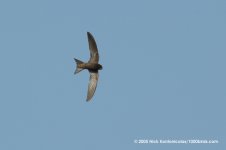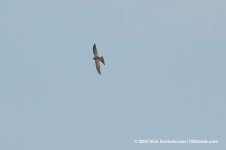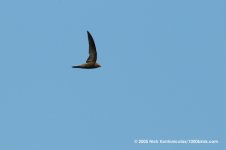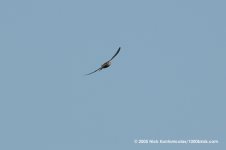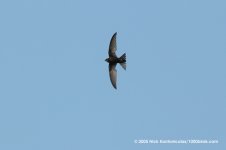I took many photos of Swifts in Northern Greece a couple of weeks ago, under the impresion they were Common Swifts. However, now that I am looking at them, I think that they are mostly Pallid (Pic #24124,24250,24191,24120) and a few Common (#24156). What do you think?
-
Welcome to BirdForum, the internet's largest birding community with thousands of members from all over the world. The forums are dedicated to wild birds, birding, binoculars and equipment and all that goes with it.
Please register for an account to take part in the discussions in the forum, post your pictures in the gallery and more.
You are using an out of date browser. It may not display this or other websites correctly.
You should upgrade or use an alternative browser.
You should upgrade or use an alternative browser.
Pallid vs Common Swift (1 Viewer)
- Thread starter Nickk
- Start date
More options
Who Replied?Reader
Well-known member
Nickk said:I took many photos of Swifts in Northern Greece a couple of weeks ago, under the impresion they were Common Swifts. However, now that I am looking at them, I think that they are mostly Pallid (Pic #24124,24250,24191,24120) and a few Common (#24156). What do you think?
Hi Nickk
I find it quite hard to sort out Pallid's without them being amongst their comparison species, the Common Swift, but studying your photos this is what I think.
A. Paillid
B. I'm fairly sure Pallid
C. Common I think (The wing tips seemed more pointed)
D. Can't tell from this angle but the whiteish head leads me to think Pallid.
E. Common I think (again I think the wing tips seemed more pointed)
The salient points to look out for with comparison with the two species are. Pallid has more rounded wing tips, not such a forked tail, structually a broader head & body and a paler look to the bird. The latter being possibly one of the harder to sort out unless you see the bird against a darker background.
I await to be shot down on my thoughts but I feel relatively confident on.
It is quite hard to ID these birds without having Common Swifts with them for comparison but it can be done. I have managed to ID at least two birds in Britain but I was lucky on both occasions having the birds fly low with dark backgrounds behind them. This helped enormously as the pale colour and dark mantle stood out.
Julian Sykes Wildlife
Jules Sykes
Hi Nick
I would have to say that all these have the potential for Pallid with only the last one being possibly Common.
As well as what Reader says I find the id clinches to be large white throat patch, wing shape, a notched inner wing, upperwing contrast (when seen well), and a dark eye mask.
A & B as Reader says.
I think C is a Pallid because it shows a clear eye mask and the notching to the inner wing. The throat patch isn't visible but I think the angle of the head is putting it in shadow.
D as Reader says, a very strong throat patch.
E Common (I could be wrong), as Reader says very pointed wings, only hint of a throat patch, all-over darkish impression.
I would have to say that all these have the potential for Pallid with only the last one being possibly Common.
As well as what Reader says I find the id clinches to be large white throat patch, wing shape, a notched inner wing, upperwing contrast (when seen well), and a dark eye mask.
A & B as Reader says.
I think C is a Pallid because it shows a clear eye mask and the notching to the inner wing. The throat patch isn't visible but I think the angle of the head is putting it in shadow.
D as Reader says, a very strong throat patch.
E Common (I could be wrong), as Reader says very pointed wings, only hint of a throat patch, all-over darkish impression.
mike coleman
BF Irregular
It doesn't work with photos (funnily enough) but I always find that hearing them helps in the field...
With these, it would appear that only the last one looks like a Common, just on the lack of scaled appearance and overall darkish impression, the others look good for Pallid, even the pointy wings of the middle one.
With these, it would appear that only the last one looks like a Common, just on the lack of scaled appearance and overall darkish impression, the others look good for Pallid, even the pointy wings of the middle one.
Edward woodwood
Member
all Pallid for me
I lived in northern Greece and can't remember seeing many Common there
field id is extremely tricky except under the most favourable conditions
i've always found most features to be next to useless in the field although you can pick up the jizz after a lot of practice. Wingtip shape and contrast between coverts and rest of wing best feature for me
Tim
Tim
I lived in northern Greece and can't remember seeing many Common there
field id is extremely tricky except under the most favourable conditions
i've always found most features to be next to useless in the field although you can pick up the jizz after a lot of practice. Wingtip shape and contrast between coverts and rest of wing best feature for me
Tim
Tim
doug_newman
Well-known member
check out www.zestforbirds.co.za. Under the rarities page there is a nice link to photos comparing Common and Pallid Swifts as Pallid is a rarity in SA (Near the bottom of the list as it was seen towards the beginning of the year).
hannu
Well-known member
hannu
Well-known member
will bowell
Will the wandering birder
All Pallid's I would say.....
The third one, although has pointy wings is definitely Pallid- just look at that face and scalling. The last one also shows a bit of scalling and looks standard Pallid to me.
Will
The third one, although has pointy wings is definitely Pallid- just look at that face and scalling. The last one also shows a bit of scalling and looks standard Pallid to me.
Will
hannu
Well-known member
Common can have a quite large white throat patch,
see follow link:
http://ddkkk.1g.fi/apus/Apuapu 20040807 Laajal 8507.jpg
Also how we can disqualify A.apus ssp 'pekinensis' ?
Interesting link on the matter...
www.zmuc.dk/VerWeb/STAFF/kthorup/Kt-pdf/DOFT95-169high.pdf
see follow link:
http://ddkkk.1g.fi/apus/Apuapu 20040807 Laajal 8507.jpg
Also how we can disqualify A.apus ssp 'pekinensis' ?
Interesting link on the matter...
www.zmuc.dk/VerWeb/STAFF/kthorup/Kt-pdf/DOFT95-169high.pdf
Last edited:
Hi all,
From an e-mail sent by Peter Flint to the WestPalBirds mailing group on 4th July last year:
'Even in June many of the birds (Pallid Swifts in Cyprus) were in primary
moult, earlier than the dates given in BWP for European birds. Also, according to BWP, Swifts Apus apus start their primary moult on arrival in winter quarters, and only exceptionally start in summer. So primary moult in a swift seen in Europe in summer may be an indication that it is likely to be Pallid.'
Since the birds in Pic 2 and 5 at least appear to be in active moult, with the upperpart colouration also looking good in No.2, these would appear to be Pallid Swifts on this feature alone?
The bird in No.4 also looks good for Pallid to me, for reasons mentioned by others, and No.1 could well be one also (THINK I can see pale 'scaling' on the underparts?), leaving No.3 as the toughest call.
Regards,
Harry
From an e-mail sent by Peter Flint to the WestPalBirds mailing group on 4th July last year:
'Even in June many of the birds (Pallid Swifts in Cyprus) were in primary
moult, earlier than the dates given in BWP for European birds. Also, according to BWP, Swifts Apus apus start their primary moult on arrival in winter quarters, and only exceptionally start in summer. So primary moult in a swift seen in Europe in summer may be an indication that it is likely to be Pallid.'
Since the birds in Pic 2 and 5 at least appear to be in active moult, with the upperpart colouration also looking good in No.2, these would appear to be Pallid Swifts on this feature alone?
The bird in No.4 also looks good for Pallid to me, for reasons mentioned by others, and No.1 could well be one also (THINK I can see pale 'scaling' on the underparts?), leaving No.3 as the toughest call.
Regards,
Harry
Ghostly Vision
Well-known member
Excellent deduction Harry, as I thought, like Jules and others above, that all were Pallid except the last one. I guess your moult thing means they are all Pallid then
GV
GV
Edward woodwood
Member
Ghostly Vision said:Excellent deduction Harry, as I thought, like Jules and others above, that all were Pallid except the last one. I guess your moult thing means they are all Pallid then
GV
yes sean, see my post above. A lot of experience with em makes it a bit easier.
they used to nest in my roof
Tim
Ghostly Vision
Well-known member
Alright there Timmeeh
You're right about the field features cf jizz thing; when seen in the flesh, Pallids just look like Pallids. I especially find the "blunt wing tip" thing a bit difficult to pin down in the field (easy from photo's though)
That last pic looks a helluva lot like a Common swift to me though.
GV
You're right about the field features cf jizz thing; when seen in the flesh, Pallids just look like Pallids. I especially find the "blunt wing tip" thing a bit difficult to pin down in the field (easy from photo's though)
That last pic looks a helluva lot like a Common swift to me though.
GV
stuart winter
My Eyes Have Seen the Glory of the Cups at WHL
If I had to tell the truth I cannot see a typical Pallid in any the pics. The primary ratios all seem to favour the pointed impression of Common rather than Pallid. Additionally there doesn't seem to be any sign of the contrast between the dark outer primaries and lighter inner ones which is one of the better Pallid field marks. The general colour tones all seem to favour Common as well, but seeing that last week's Greenshank had red legs on my screen I don't dare trust it any longer.
stuart winter
My Eyes Have Seen the Glory of the Cups at WHL
That said, the bird in B does have a dark saddle which is a good Pallid pointer. Harry's remarks on moult are excellent, but I am pretty positive I have Common Swifts in wing moult, particularly the secondaries, in August time here in the UK.
S
S
I'm glad I'm not the only one thinking this. At the time this post was started I was in Spain, seeing plenty of both species. (I agree with GV that the blunt wings of Pallid are not nearly so easy to see in the field as the books make out - nor was the dark eye mark!) I thought I was beginning to get a feel for the difference and when I saw these pics none of them struck me as certain Pallids. I'm not saying they're Common; I'm just saying I'm now feeling very depressed!stuart winter said:If I had to tell the truth I cannot see a typical Pallid in any the pics. The primary ratios all seem to favour the pointed impression of Common rather than Pallid. Additionally there doesn't seem to be any sign of the contrast between the dark outer primaries and lighter inner ones which is one of the better Pallid field marks. The general colour tones all seem to favour Common as well, but seeing that last week's Greenshank had red legs on my screen I don't dare trust it any longer.
Moult is primaries descendant and suspended until arrival (or starts, as is the norm for Common) on winter grounds so it does not affect wing tip shape in August.
Agree that 1-4 look like Pallid. Not sure of 5 but wing tip is Pallid-like for me (last primary clearly shorter than previous).
Agree that 1-4 look like Pallid. Not sure of 5 but wing tip is Pallid-like for me (last primary clearly shorter than previous).
Users who are viewing this thread
Total: 2 (members: 0, guests: 2)




